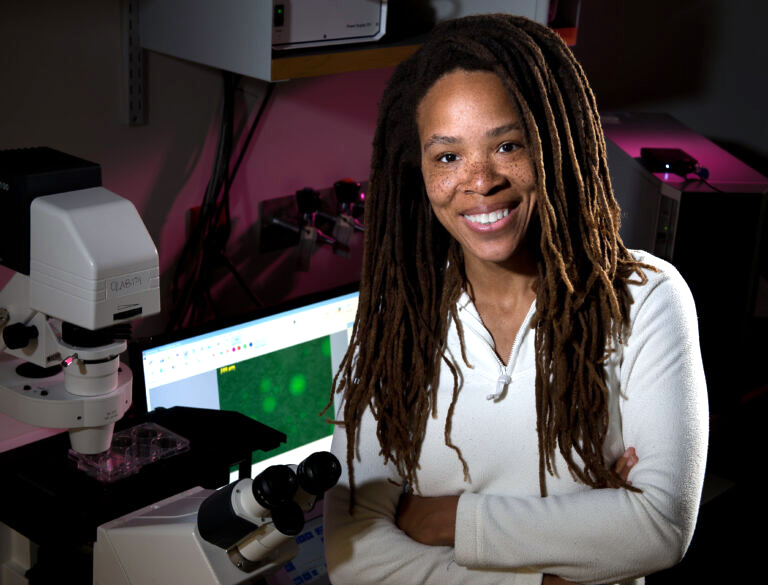
May 11, 2021 - In a lab on the upper floors of Engineering Hall, something is growing.
It’s not a plant. And it’s not an animal.
What Ronke Olabisi is growing in her lab is us. From new skin and retinal tissue to hearts and livers, she’s developing the tools to rebuild and repair the human body.
A UCI assistant professor of biomedical engineering, Olabisi has been working with regenerative tissue for the better part of seven years, using a hydrogel based on polyethylene glycol diacrylate.
“Think about this: When you’re building a building, they put up scaffolding, and people will slowly build that building around the scaffolding,” she says. “Tissue engineers use hydrogels as scaffolding that’s eventually going to be dissolved away in some manner or another. And the hope is that cells can build new tissue around that scaffolding.”
There are a lot of different scaffoldings that researchers use. Some are natural, and some are completely synthetic. Olabisi’s research focuses on an artificial scaffolding, as it gives her the freedom to manipulate the compound molecule by molecule.
“I can observe what happens when I add a particular growth factor and see how the tissue develops,” Olabisi says. “And that kind of manipulation tells me what my scaffolding is doing for my system.”
The scaffolding, which begins as substrate typically purchased from a third party as a powder or liquid, is combined with a special material unique to Olabisi’s work to form the active component in the next step of her research, decellularization. This is the process of isolating the extracellular matrix that makes up the organ requiring repair, which can then be used as a framework on which to rebuild tissue.
Olabisi’s work is not limited to terrestrial applications, however. In 2013, she joined the 100 Year Starship coalition of scientists, researchers and others across the country focused on developing the technologies necessary for humans to travel to and colonize another star system within 100 years.
“In 1961, President Kennedy said, ‘Let’s go to the moon,’ and in 1969, we landed on the moon,” Olabisi explains. “The technology that came out of that completely transformed the world. Now what if they had decided to go in 1869? How would the world have changed with that?”
Research into everything from suspended animation to renewable energy is based on cutting-edge science, and Olabisi’s work is no different. Innovations in her lab may one day have the ability to regenerate decaying tissues. By grafting a synthetic scaffold in an affected area, new treatments could be applied to chronic wounds, could ameliorate the effects of aging and could help soothe burn victims.
While groundbreaking, Olabisi’s work has yet to reach clinical trials. Traditionally, it can take up to 20 years for an idea to go from conceptualization to market. First comes testing with small animals, typically rodents, then larger mammals and, ultimately, a target population of humans.
“So all of this can take years upon years upon years,” Olabisi says. “However, you can accelerate the speed at which this happens if any component of your work has been tested in people before.”
Fortunately, her main component, polyethylene glycol diacrylate, has undergone extensive human testing, and her cell regenerative therapy is in the preclinical stage, demonstrating that it can help heal wounds faster than traditional methods.
“It’s close to helping people,” Olabisi says, “probably in 10 to 15 years.”
UCI’s Brilliant Future campaign, publicly launched on Oct. 4, 2019, aims to raise awareness and support for the university. By engaging 75,000 alumni and garnering $2 billion in philanthropic investment, UCI seeks to reach new heights of excellence in student success, health and wellness, research and more. The Henry Samueli School of Engineering plays a vital role in the success of the campaign. Learn more by visiting: https://brilliantfuture.uci.edu/the-henry-samueli-school-of-engineering/.
– Ian Michael Anzlowar / UCI
